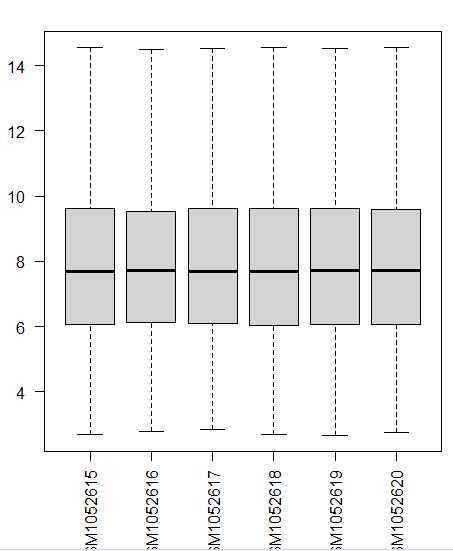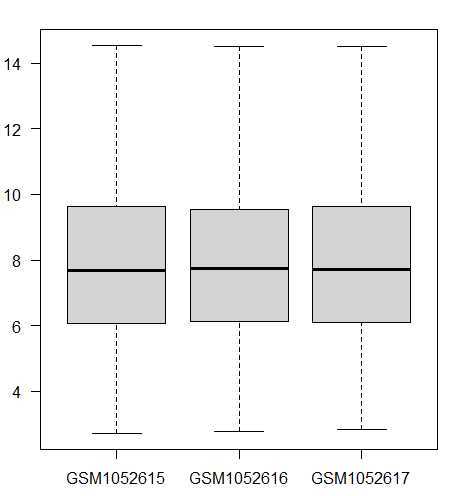f=‘GSE42872_eSet.Rdata‘ ##原文操作如此,是不是作者的习惯,先命名
# https://www.ncbi.nlm.nih.gov/geo/query/acc.cgi?acc=GSE42872
library(GEOquery)
# 这个包需要注意两个配置,一般来说自动化的配置是足够的。
#Setting options(‘download.file.method.GEOquery‘=‘auto‘)
#Setting options(‘GEOquery.inmemory.gpl‘=FALSE)
##因为安装包的问题我把Rstudio关了,所以这里getGEO从本地读取文件
##gset <- getGEO(filename = "GSE42872_series_matrix.txt.gz")
##问题出来了,用getGEO
> gset_42872 <- getGEO(filename = "GSE42872_series_matrix.txt.gz") Parsed with column specification: cols( ID_REF = col_double(), GSM1052615 = col_double(), GSM1052616 = col_double(), GSM1052617 = col_double(), GSM1052618 = col_double(), GSM1052619 = col_double(), GSM1052620 = col_double() ) |===================================================================| 100% 1 MB Using locally cached version of GPL6244 found here: C:\Users\Mark\AppData\Local\Temp\RtmpM1jsvM/GPL6244.soft > class(gset_42872) ##得到的gset_42872等同于下面程序中的对象a,是ExpressionSet类型,而不是原文中的list类型??? [1] "ExpressionSet" attr(,"package") [1] "Biobase"
##当本地存在GSE42872...gz这个文件时,getGEO会从本地读取。
> gset <- getGEO("GSE42872",destdir = ".",AnnotGPL = F,getGPL = F) Found 1 file(s) GSE42872_series_matrix.txt.gz Using locally cached version: ./GSE42872_series_matrix.txt.gz
if(!file.exists(f)){
gset <- getGEO(‘GSE42872‘, destdir=".",
AnnotGPL = F, ## 注释文件
getGPL = F) ## 平台文件
save(gset,file=f) ## 保存到本地
}
load(‘GSE42872_eSet.Rdata‘) ## 载入数据--载入数据干嘛?从后面看似乎并没有用到这个。
class(gset)
> class(gset)
[1] "list"
length(gset)
class(gset[[1]]) ##既然gset是个list,gset[[1]]表示访问其第一个元素本身。返回的是ExpressionSet类型
> class(gset[[1]])
[1] "ExpressionSet"
attr(,"package")
[1] "Biobase"
gset
> gset
$GSE42872_series_matrix.txt.gz ##列表以$符号开头
ExpressionSet (storageMode: lockedEnvironment)
assayData: 33297 features, 6 samples
element names: exprs
protocolData: none
phenoData
sampleNames: GSM1052615 GSM1052616 ... GSM1052620 (6 total)
varLabels: title geo_accession ... cell type:ch1 (34 total)
varMetadata: labelDescription
featureData: none
experimentData: use ‘experimentData(object)‘
pubMedIds: 24469106
Annotation: GPL6244
# 因为这个GEO数据集只有一个GPL平台,所以下载到的是一个含有一个元素的list--所以有几个注释的GPL平台,该list就有几个元素是吗?
a=gset[[1]] #gset[[1]]取第一个元素本身
dat=exprs(a) #a现在是一个对象,取a这个对象通过看说明书知道要用exprs这个函数 怎么看出来啊??还有exprs()是什么函数?
dim(dat)#看一下dat这个矩阵的维度
> a = gset[[1]] > class(a) [1] "ExpressionSet" attr(,"package") [1] "Biobase" > dat = exprs(a) > class(dat) [1] "matrix" "array" > dim(dat) ##33697行 6列 [1] 33297 6 > head(dat) GSM1052615 GSM1052616 GSM1052617 GSM1052618 GSM1052619 GSM1052620 7892501 7.24559 6.80686 7.73301 6.18961 7.05335 7.20371 7892502 6.82711 6.70157 7.02471 6.20493 6.76554 6.24252 7892503 4.39977 4.50781 4.88250 4.36295 4.18137 4.73492 7892504 9.48025 9.67952 9.63074 9.69200 9.91324 9.65897 7892505 4.54734 4.45247 5.11753 4.87307 5.15505 3.99340 7892506 6.80701 6.90597 6.72472 6.77028 6.77058 6.77685
# GPL6244
dat[1:4,1:4] #查看dat这个矩阵的1至4行和1至4列,逗号前为行,逗号后为列
boxplot(dat,las=2) ##boxplot()表示画箱线图,类似K线。las = 2好像表示横轴label与横轴垂直,las=1表示平行

> boxplot(dat[,1:3],las = 1 )

pd=pData(a) #通过查看说明书知道取对象a里的临床信息用pData?怎么看出来的啊?
> pd = pData(a) > class(pd) [1] "data.frame" > dim(pd) [1] 6 34 > head(pd[,c(1,34)],n =2) title cell type:ch1 GSM1052615 A375 cells 24h Control rep1 Melanoma cell line GSM1052616 A375 cells 24h Control rep2 Melanoma cell line
## 挑选一些感兴趣的临床表型。如何挑?
library(stringr)
group_list=str_split(pd$title,‘ ‘,simplify = T)[,4] ##单引号中间是有个空格的!表示以空格将取出的title这一列分隔开,然后取第四列
table(group_list)
> library(stringr) > group_list = str_split(pd$title," ",simplify = T)[,4] > class(group_list) [1] "character" > group_list [1] "Control" "Control" "Control" "Vemurafenib" "Vemurafenib" [6] "Vemurafenib" > table(group_list) group_list Control Vemurafenib 3 3
> x = str_split(pd$title," ",simplify = T) ##看看str_split()之后得到的到底是个啥,simplify = T,返回的是一个6行5列的字符矩阵。 > class(x) [1] "matrix" "array" > dim(x) [1] 6 5 > x [,1] [,2] [,3] [,4] [,5] [1,] "A375" "cells" "24h" "Control" "rep1" [2,] "A375" "cells" "24h" "Control" "rep2" [3,] "A375" "cells" "24h" "Control" "rep3" [4,] "A375" "cells" "24h" "Vemurafenib" "rep1" [5,] "A375" "cells" "24h" "Vemurafenib" "rep2" [6,] "A375" "cells" "24h" "Vemurafenib" "rep3" > dim(pd) ##pd是个6行34列的数据框, [1] 6 34
这里关于str_split(),simplify = F,默认情况下,返回的是含有6个元素-每个元素都是一个字符向量的的列表
> x = str_split(pd$title," ",simplify = F) > x [[1]] [1] "A375" "cells" "24h" "Control" "rep1" [[2]] [1] "A375" "cells" "24h" "Control" "rep2" [[3]] [1] "A375" "cells" "24h" "Control" "rep3" [[4]] [1] "A375" "cells" "24h" "Vemurafenib" "rep1" [[5]] [1] "A375" "cells" "24h" "Vemurafenib" "rep2" [[6]] [1] "A375" "cells" "24h" "Vemurafenib" "rep3"
dat[1:4,1:4]
# GPL6244
if(F){
library(GEOquery)
#Download GPL file, put it in the current directory, and load it:
gpl <- getGEO(‘GPL6244‘, destdir=".")
colnames(Table(gpl))
head(Table(gpl)[,c(1,15)]) ## you need to check this , which column do you need
probe2gene=Table(gpl)[,c(1,15)]
head(probe2gene)
library(stringr)
save(probe2gene,file=‘probe2gene.Rdata‘)
}
#
# load(file=‘probe2gene.Rdata‘)
# ids=probe2gene
> colnames(Table(gpl)) [1] "ID" "GB_LIST" "SPOT_ID" [4] "seqname" "RANGE_GB" "RANGE_STRAND" [7] "RANGE_START" "RANGE_STOP" "total_probes" [10] "gene_assignment" "mrna_assignment" "category" > class(Table(gpl)) [1] "data.frame" > ls() [1] "a" "dat" "f" "gpl" "group_list" [6] "gset" "pd" "x" > y <- Table(gpl) ##y似乎没有被用到 > dim(y) ##12列 [1] 6428 12 > colnames(Table(gpl)) [1] "ID" "GB_LIST" "SPOT_ID" [4] "seqname" "RANGE_GB" "RANGE_STRAND" [7] "RANGE_START" "RANGE_STOP" "total_probes" [10] "gene_assignment" "mrna_assignment" "category" > head(Table(gpl)[,c(1,15)]) ##只有12列 Error in `[.data.frame`(Table(gpl), , c(1, 15)) : undefined columns selected
> head(Table(gpl)[,c(1,12)]) ##原文这里都是15,查看NCBI GEO数据框原始的GPL6244,只有12列。我猜这里是要取第一和最后一列,就自取c(1,12)了 ID category 1 7896736 main 2 7896738 main 3 7896740 main 4 7896742 main 5 7896744 main 6 7896746 main > probe2gene = Table(gpl)[,c(1,12)] > head(probe2gene) ID category 1 7896736 main 2 7896738 main 3 7896740 main 4 7896742 main 5 7896744 main 6 7896746 main > library(stringr) > save(probe2gene,file = "probe2gene.Rdata")
library(hugene10sttranscriptcluster.db)
ids=toTable(hugene10sttranscriptclusterSYMBOL) #toTable这个函数:通过看hgu133plus2.db这个包的说明书知道提取probe_id(探针名)和symbol(基因名)的对应关系的表达矩阵的函数为toTable
head(ids) #head为查看前六行
> library(hugene10sttranscriptcluster.db) ##这个包直接搜名字,然后在是Bioconductor的包 > ids = toTable(hugene10sttranscriptclusterSYMBOL) > class(ids) ##习惯性查看创建的对象类型 [1] "data.frame" > dim(ids) ##然后如果是数据框、矩阵就看行列数,懒得用nrow()和ncol()了 [1] 19814 2 > head(ids) ##这里看出这个ids是探针ID和symbol(基因名)一一对应的一个列表 probe_id symbol 1 7896759 LINC01128 2 7896761 SAMD11 3 7896779 KLHL17 4 7896798 PLEKHN1 5 7896817 ISG15 6 7896822 AGRN
colnames(ids)=c(‘probe_id‘,‘symbol‘)
ids=ids[ids$symbol != ‘‘,]
> colnames(ids) = c("probe_id","symbol") ##很奇怪ids的列名本来就是probe_id symbol,为啥这里有重新赋值一次 > ids = ids[ids$symbol != "",] ##原文引号内应该是空字符,这里取原ids的symbol不为空的行,重新赋值给ids > dim(ids) [1] 19814 2 > head(ids) probe_id symbol 1 7896759 LINC01128 2 7896761 SAMD11 3 7896779 KLHL17 4 7896798 PLEKHN1 5 7896817 ISG15 6 7896822 AGRN
ids=ids[ids$probe_id %in% rownames(dat),]
> ids = ids[ids$probe_id %in% rownames(dat),] ##应该把probe_id这一列与dat行名一致的行取出来,再赋值给ids。那不一致的行呢? > dat = dat[ids$probe_id,] ##然后用上面一致的行名在dat中挑一遍,再赋值给dat
> dim(ids) [1] 19814 2 > dim(dat) ##dat原来是33297列,现在列数与ids相同 [1] 19814 6
dat[1:4,1:4]
dat=dat[ids$probe_id,]
ids$median=apply(dat,1,median) #ids新建median这一列,列名为median,同时对dat这个矩阵按行操作,取每一行的中位数,将结果给到median这一列的每一行
> ids$median = apply(dat,1,median) ##apply()求dat每行的median,1表示每行 > head(ids, n= 3) probe_id symbol median 1 7896759 LINC01128 8.534290 2 7896761 SAMD11 8.814165 3 7896779 KLHL17 8.172010
ids=ids[order(ids$symbol,ids$median,decreasing = T),]#对ids$symbol按照ids$median中位数从大到小排列的顺序排序,将对应的行赋值为一个新的ids
> ids = ids[order(ids$symbol,ids$median,decreasing = T),] ##order()默认返回按升序排列的索引值
> head(ids,n = 3) probe_id symbol median 1397 7917103 ZZZ3 11.37165 7922 8011542 ZZEF1 9.79119 16662 8136918 ZYX 10.85015 > head(ids,n = 6) ##似乎并不是从大到小排列,要弄明白 probe_id symbol median 1397 7917103 ZZZ3 11.371650 7922 8011542 ZZEF1 9.791190 16662 8136918 ZYX 10.850150 349 7901479 ZYG11B 10.498800 350 7901497 ZYG11A 5.697845 13475 8090351 ZXDC 10.131450 > dim(ids) [1] 19814 3
ids=ids[!duplicated(ids$symbol),]#将symbol这一列取取出重复项,‘!‘为否,即取出不重复的项,去除重复的gene ,保留每个基因最大表达量结果s
> ids = ids[!duplicated(ids$symbol),] > dim(ids) ##列数减少了,也就是说有多个探针对应一个probe_id [1] 18821 3
dat=dat[ids$probe_id,] #新的ids取出probe_id这一列,将dat按照取出的这一列中的每一行组成一个新的dat
rownames(dat)=ids$symbol#把ids的symbol这一列中的每一行给dat作为dat的行名
dat[1:4,1:4] #保留每个基因ID第一次出现的信息
> dat = dat[ids$probe_id,] ##用ids中symbol去重复之后的probe_id,再挑一次dat,组成新的dat > dim(dat) [1] 18821 6 > head(dat) ##可以看到,此时da的行名还是probe_id GSM1052615 GSM1052616 GSM1052617 GSM1052618 GSM1052619 GSM1052620 7917103 11.26970 11.12560 11.23260 11.47360 11.55680 11.47480 8011542 9.63412 9.44327 9.67075 9.96091 10.02970 9.91163 8136918 10.89980 10.93190 10.91850 10.71250 10.56110 10.80050 7901479 10.48080 10.32370 10.51680 10.74500 10.65980 10.38960 7901497 5.76104 5.89974 6.00656 5.56078 5.63465 5.56169 8090351 10.10980 10.10570 10.19240 10.24110 10.15310 10.06140 > rownames(dat) = ids$symbol ##可以直接这样的原因在于用dat[ids$probe_id,]得到新的dat之后,行名顺序与ids的probe_id列的是一样的 > head(dat) ### GSM1052615 GSM1052616 GSM1052617 GSM1052618 GSM1052619 GSM1052620 ZZZ3 11.26970 11.12560 11.23260 11.47360 11.55680 11.47480 ZZEF1 9.63412 9.44327 9.67075 9.96091 10.02970 9.91163 ZYX 10.89980 10.93190 10.91850 10.71250 10.56110 10.80050 ZYG11B 10.48080 10.32370 10.51680 10.74500 10.65980 10.38960 ZYG11A 5.76104 5.89974 6.00656 5.56078 5.63465 5.56169 ZXDC 10.10980 10.10570 10.19240 10.24110 10.15310 10.06140
save(dat,group_list,file = ‘step1-output.Rdata‘)
> save(dat,group_list,file = "step1-output.Rdata") ##.RData以二进制的方式保存了会话中的变量值 > ?save > ls() [1] "a" "dat" "f" "gpl" "group_list" [6] "gset" "ids" "pd" "probe2gene" "x" [11] "y" > save("gpl","group_list","gset","ids","pd","probe2gene","a","x","y",file = "step1-all-test-files.Rdata")#保留所有新建的变量
然后在新Rstudio窗口中打开这个.Rdata文件,运行如下
> load("D:/RStudy/RScript/test_GSE42872_first try/step1-all-test-files.Rdata") ##load()读取.Rdata文件,绝对路径 Loading required package: Biobase Loading required package: BiocGenerics Loading required package: parallel Attaching package: ‘BiocGenerics’ The following objects are masked from ‘package:parallel’: clusterApply, clusterApplyLB, clusterCall, clusterEvalQ, clusterExport, clusterMap, parApply, parCapply, parLapply, parLapplyLB, parRapply, parSapply, parSapplyLB The following objects are masked from ‘package:stats’: IQR, mad, sd, var, xtabs The following objects are masked from ‘package:base’: anyDuplicated, append, as.data.frame, basename, cbind, colnames, dirname, do.call, duplicated, eval, evalq, Filter, Find, get, grep, grepl, intersect, is.unsorted, lapply, Map, mapply, match, mget, order, paste, pmax, pmax.int, pmin, pmin.int, Position, rank, rbind, Reduce, rownames, sapply, setdiff, sort, table, tapply, union, unique, unsplit, which, which.max, which.min Welcome to Bioconductor Vignettes contain introductory material; view with ‘browseVignettes()‘. To cite Bioconductor, see ‘citation("Biobase")‘, and for packages ‘citation("pkgname")‘. Loading required package: GEOquery Setting options(‘download.file.method.GEOquery‘=‘auto‘) Setting options(‘GEOquery.inmemory.gpl‘=FALSE) > group_list [1] "Control" "Control" "Control" "Vemurafenib" "Vemurafenib" [6] "Vemurafenib"
以上内容from https://github.com/jmzeng1314/GEO/blob/master/GSE42872_main/step1-download.R,在其基础上有自己的思考。
> gset$GSE42872_series_matrix.txt.gzExpressionSet (storageMode: lockedEnvironment)assayData: 33297 features, 6 samples element names: exprs protocolData: nonephenoData sampleNames: GSM1052615 GSM1052616 ... GSM1052620 (6 total) varLabels: title geo_accession ... cell type:ch1 (34 total) varMetadata: labelDescriptionfeatureData: noneexperimentData: use ‘experimentData(object)‘ pubMedIds: 24469106 Annotation: GPL6244
原文:https://www.cnblogs.com/SWTwanzhu/p/13022162.html